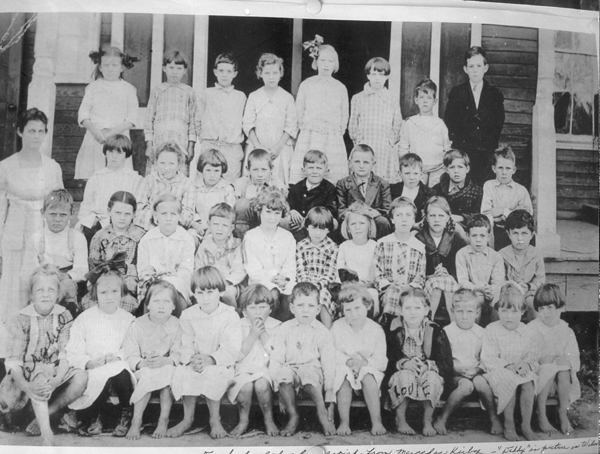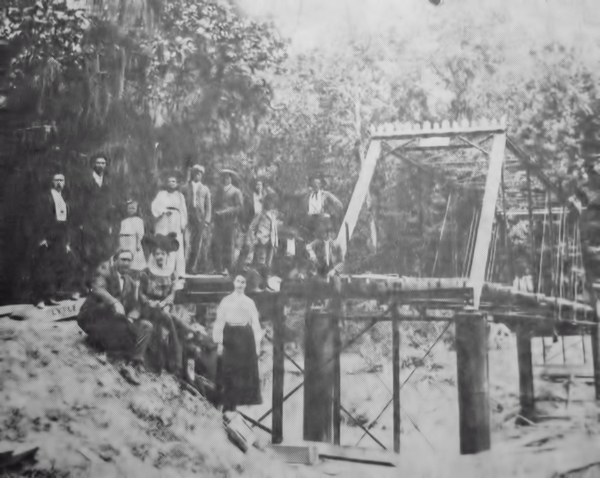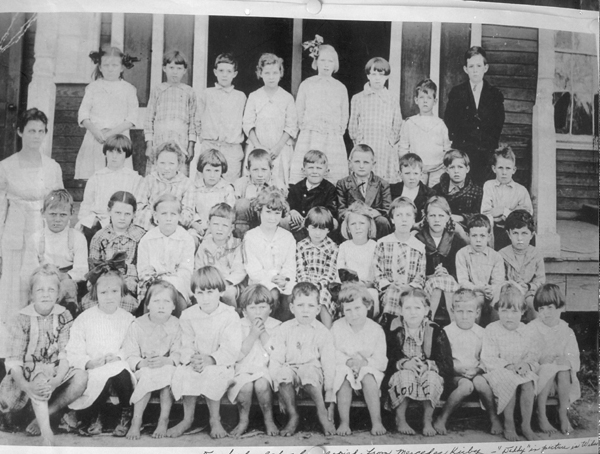Community
A History of Deerford
By Lewis J. Kelly
(First published in the State Times in 1914, courtesy of the Central Historical Society. This paper was donated to them from Alice Easterly Robert’s collection.)
Above: Deerford School c. early 1900’s: Top Row:Bessie Partin, Bafronia Austin, Virgil Noble, Estelle Black, Dorothy Hutchinson, Eunice Millican, Lano Woodward, T.F. Aucoin;
3rd row: Teacher Maurie Millican, Josie Forbes, Vera Hubbs, Jessie Long, B B Parl, Maxie Thomas, Jack Noble, Hilton Kent, T. Whitehead, Harvey Kent;
2nd row: I.Gurney, Alma Noble, Edna Pullam, Wilson Kirby, Mary Ella Mahoney, Doris Millican, Annie Farrier, Lula Tucker, Gladys Hutchinson, Eli Noble, Wycliff Wascom 1st row: Arabel Noble, Edith Law, Estelle Hutchinson, Alexana Forbes, Sarah Austin, Lindsey A., Maggie Lou Mahoney, Lovie Noble, Leon Gurney, Virginia Alford, Florence Forbes (Some of the handwritten names had to be deciphered. Please help us correct errors)
The J.H. Millican store and the Methodist church form the center of the town. The very old community has a very interesting history. Mrs. Alphonse Forbes of Indian Mound gave us the history of the town as written by her now deceased step grandfather, Mr. Lewis J. Kelly. During his life Mr. Kelly was one of the most-loved citizens in the community. In his early life he formed the habit of keeping a record of the happenings in the neighborhood. On the 12th day of January of 1881 he was appointed the first postmaster of Deerford. He held the old commission until his death, though seven men have served since then. Here is Mr. Kelly’s history of Deerford. How different the town is now that it has the benefit of co-op electricity.
The name Deerford was given to this place by Thomas Carpenter, the pioneer settler who located here about 1849. It was a ford made by deer in crossing Sanders’ Bayou as they chanced to be going east or west. There were open woods on both sides of the bayou at that place. To the south and west there was a thick, heavy cane break, vines and other undergrowth. There was also a large pigeon roost which was so thick and dark that lighting bugs could be seen there at 12 o’clock in the daytime. To the east and north the woods were not so thick as in other directions. The bayou was named after Jude Sanders of Clinton, LA, who entered a large tract of land below Deerford in 1839. According to the government sub-divisions of the public lands, the old deer ford was located in the west half of the southwest quarter of Section 1 Township 5 south, Range 1 east, St. Helena Meridian.
Above: Picnic on the Comite River Joor Bridge near Fred, LA, 1889
The early conditions around Deerford from 1849 to 1856 were about the same as all other new settlements of that day. The early settlers lived in rude cabins built of materials closest at hand in the forest. Some had round log houses with plank floors; others had split log houses with puncheon floors, others had dirt floors.
The tools for farming were very few and consisted of the old jack and half shovel plow, made in the nearby shops, and harrows made at home of forked trees with wooden pine for teeth.
The roads in 1852 were only wide enough for one yoke of oxen and a cart, but they were gradually cut wide for large teams. At the time there were two such roads. One came from Sandy Creek and crossed the Comite River at the Whitehead Ford near Mrs. S. J. Hunt’s and intersected the Plank road at Dr. Wall’s place. This road forked where Mr. J.H. Tucker now lives, and the south fork crossed the Comite about two miles lower down at Allen’s Ford and intersected the Plank Road at Mrs. Bankston’s store. The other road came form the Long and Odom neighborhood in the Tenth Ward, crossed the first road just east of Deerford and went northeast to Mrs. Nelson Kirby’s place, where it forked; one fork went on northeast to where Pride post office is now situated; the other went north to the Norwood and Chaney neighborhood on the Comite River.
Above: John Millican Store – Deerford and Blackwater
The first public road was laid out in 1858 by a committee appointed by the police jury. The committee consisted of the following men: Wilson Tate, Luther Ronaldson, A.M. Noble, W.B. Young and Thomas Carpenter. The road was known as the Port Hudson and Greenwell Spring road.
The road leading south from Deerford and known as the Joor’s Bridge Road, was laid out in 1866 by Wilson Tate, James Long, Benjamin Long, Thomas Carpenter and John Fridge commissioners. The first doctor to come to Deerford was Dr. Thomas J. Buffington of Baton Rouge. He had a Buggy drawn by two black horses. His buggy was the first in Deerford.
Up to the year 1858 there were only five farms. They were small excepting Wilson Tate’s place. He had about one hundred acres in cultivation.
In 1880 there was preaching once a month under the trees, across from there Deerford Church now is. The services were held by Old Father Uriah Vining, a Baptist preacher from Ponchatoula. There were only two church members in the settlement. They were members of Bethel Church on Sandy Creek.
In 1856 Williams Morgan from Blackwater Church neighborhood, came into the settlement and got up a school of ten pupils. There was no schoolhouse there then, but Thomas Carpenter gave his cotton house to teach in. It was a double log house made of split logs. Each room was about 12 x 15 feet. There was also a ten foot entry. All the rooms had puncheon floors. The doors were cut out facing each other, about two logs from the floor and were about 3 x 4 feet in size. The children had to step up on a block, then step high over the first two logs and stoop low to keep from bumping their heads on the upper log.
Only one room was used for a schoolroom, as the other was nearly always filled with corn and fodder. The school was in the cow lot, just in front of where Mr. Frank Tucker’s residence now stands. There is only one member of that school living today. The books used then were: Webster’s Old blue-back Spelling Book, McGuffy’s First and Second Readers, Smith’s Arithmetic and Geography, and Webster’s Speller and Definer. The copybooks were made at home of fool’s cap paper. One of the pupils used a goose quill for a pen. The tuition was $1 per month for each pupil. The school usually lasted about one month.
From then until 1875 the schools were as follows: J.R. Senom 1860-1868, George Hawley 1869, J.E. Noble 1871, Miss Curtis 1873-1874, Miss Ellen R. Usher 1874-1875. All these were private schools. The first public school was taught in 1877 by Joseph Joor.
The growth has been gradual but sure, every school being an improvement over the previous one. The influence over the people has been such as to make one of the very best communities in the state. Deerford has sent out men and women for almost every vocation. There are many things left untold about Deerford, its life and growth, but the story covers the essential facts. It shows what a community can do when the people live in the love of country life.





8 Comments